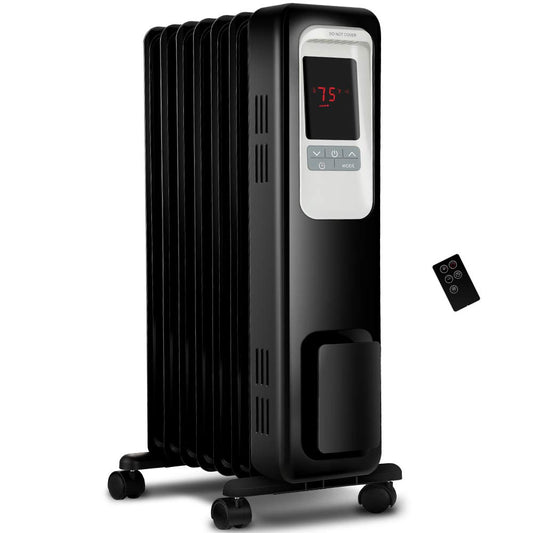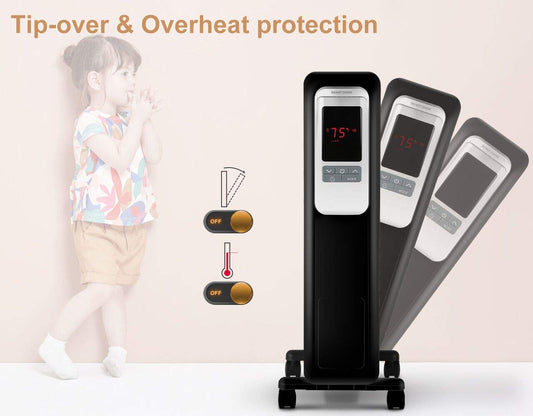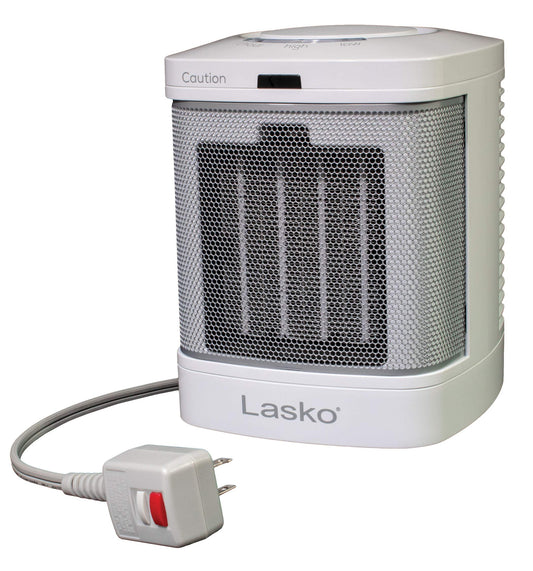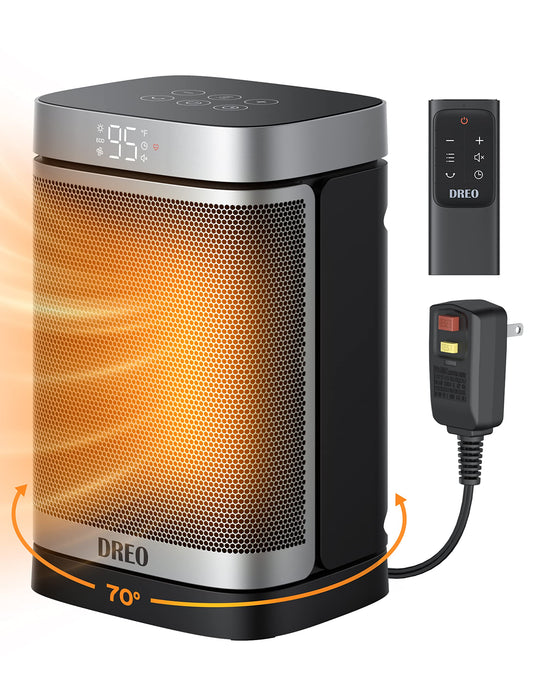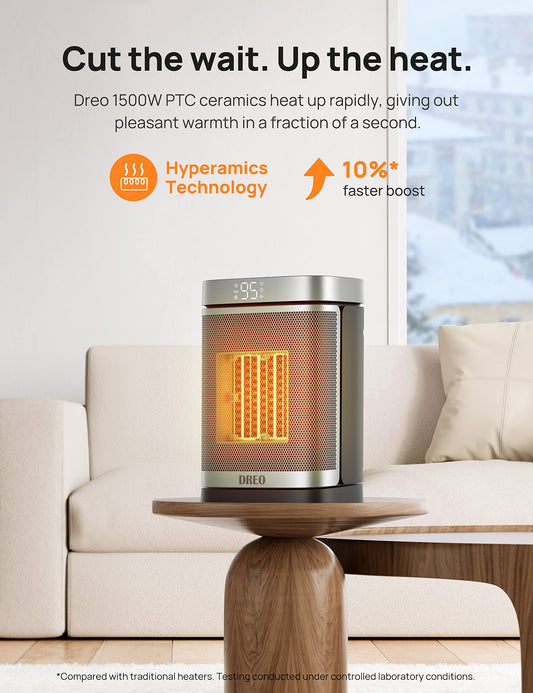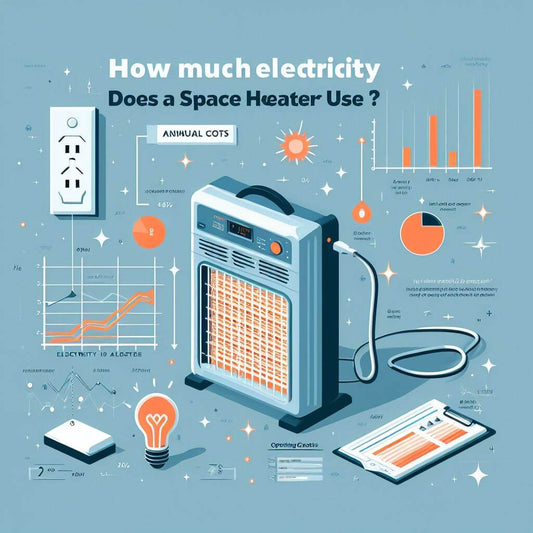Are Space Heaters Energy Efficient? A Complete Breakdown on Efficiency
Summary
Yes, space heaters are energy efficient, but only if you use them correctly. Space heaters can help you save money and energy by heating only the rooms you need, rather than the whole house.

Some links affiliate links that we may earn a commission.
Key Takeaways
- Space heaters are devices that provide supplemental or zone heating for a specific area or room.
- Energy efficiency is the ratio of useful heat output to energy input, measured in watts, kilowatt hours, or BTUs.
- Space heaters can be energy efficient if they are used properly, in well-insulated spaces, and with the right heating technology for the room size and usage patterns.
- There are different types of space heaters, such as convection, radiant, ceramic, oil-filled, and infrared heaters, each with their own advantages and disadvantages in terms of energy efficiency, safety, and comfort.
- To maximize energy efficiency, users should follow some tips, such as only using space heaters in occupied rooms, saving heat energy elsewhere if possible, proper insulation in the space, using the heater in a well-suited room size, and efficient heating habits.
- Space heaters also pose some safety risks, such as burn and fire hazards, carbon monoxide poisoning, and electric shock, so users should look for safety features, such as automatic shut-off switches, tip-over protection, CO sensors, and UL listing, and follow safety guidelines, such as keeping the heater away from flammable materials, using a power cord of adequate length and gauge, and cleaning the filters regularly.
Introduction
Space heaters are devices that provide supplemental or zone heating for a specific area or room. They can be powered by electricity, natural gas, propane, kerosene, or wood, depending on the type and model of the heater. Space heaters can be useful for adding warmth and comfort to a cold or drafty space, especially during the winter months, when the central heating system may not be sufficient or cost-effective.
However, not all space heaters are created equal. Some space heaters are more energy efficient than others, meaning they use less energy to produce the same amount of heat. Energy efficiency is the ratio of useful heat output to energy input, measured in watts, kilowatt hours, or BTUs (British thermal units). The higher the energy efficiency, the lower the operating costs and the environmental impact of the heater.
Energy efficiency is not only determined by the type and design of the heater, but also by how it is used, where it is placed, and what kind of space it is heating. Therefore, choosing and using a space heater wisely is important for saving money, energy, and the planet.
In this article, we will explore how space heaters work, what factors affect their energy efficiency, what types of space heaters are available and how they compare in terms of energy efficiency, what tips and tricks can help maximize energy efficiency, what safety considerations users should be aware of, how to calculate space heater operating costs, what common myths and misconceptions exist about energy-efficient space heaters, and what recommendations can help users choose and install the best energy-efficient heating and cooling equipment for their homes.
How Space Heaters Work
Space heaters work by converting electricity, gas, or other fuels into heat, which is then transferred to the surrounding air or objects. There are three main ways that space heaters transfer heat: convection, radiation, and infrared.
Convection Heating
Convection heating is the process of heating the air in a space, which then circulates and warms up the room. Convection heaters use a fan, a blower, or natural air currents to move the heated air around. Examples of convection heaters are baseboard heaters, fan-forced heaters, and furnaces.
Radiant Heating
Radiant heating is the process of heating objects or surfaces directly, without heating the air. Radiant heaters emit electromagnetic waves, such as visible light or infrared, that are absorbed by the objects they encounter. Examples of radiant heaters are fireplaces, wood stoves, and electric heaters with glowing coils.
Infrared Heating
Infrared heating is a type of radiant heating that uses infrared waves, which are invisible to the human eye, to heat objects or surfaces. Infrared heaters have a heating element, such as a quartz tube or a ceramic plate, that emits infrared waves when heated by electricity. Infrared heaters are more efficient than other radiant heaters, because they do not waste heat on heating the air or the heater itself.
Factors Affecting Energy Efficiency
The energy efficiency of a space heater depends on several factors, such as the heating technology used, the size and insulation of the space, and the usage patterns of the user. Are space heaters energy efficient? Here are some of the main factors that affect the energy efficiency of a space heater:
Heating Technology Used
The heating technology used by a space heater determines how much energy it consumes and how much heat it produces. Different types of space heaters have different energy efficiency ratings, which are expressed as a percentage of the energy input that is converted into heat output. The higher the energy efficiency rating, the less energy the heater uses and the more heat it delivers.
Size and Insulation of the Space
The size and insulation of the space that the space heater is heating also affect its energy efficiency. A larger or poorly insulated space will require more heat and more energy to maintain a comfortable temperature, compared to a smaller or well-insulated space. Therefore, users should choose a space heater that is appropriate for the size and insulation of the space they want to heat, and avoid using a space heater in a space that is too large or too drafty.
Usage Patterns
The usage patterns of the user also influence the energy efficiency of a space heater. Users who use a space heater for long periods of time, or who set the thermostat too high, will consume more energy and pay more on their electric bills, than users who use a space heater for short periods of time, or who set the thermostat at a moderate level. Therefore, users should use a space heater only when needed, and adjust the thermostat to the lowest comfortable setting, to save energy and money.
Types of Space Heaters and Their Energy Efficiency Ratings
There are many types of space heaters available on the market, each with their own advantages and disadvantages in terms of energy efficiency, safety, and comfort. Here are some of the most common types of space heaters and their energy efficiency ratings:
Convection Heaters
Convection heaters are space heaters that heat the air in a space, using a fan, a blower, or natural air currents. Convection heaters are suitable for heating large or open spaces, or spaces that have multiple occupants. However, convection heaters are not very energy efficient, because they lose heat to the surrounding air, and they take longer to warm up a space. Convection heaters have an average energy efficiency rating of 60%, meaning they convert 60% of the energy input into heat output.
Radiant Heaters
Radiant heaters are space heaters that heat objects or surfaces directly, using electromagnetic waves. Radiant heaters are suitable for heating small or enclosed spaces, or spaces that have a single occupant. Radiant heaters are more energy efficient than convection heaters, because they do not lose heat to the surrounding air, and they provide instant heat. Radiant heaters have an average energy efficiency rating of 70%, meaning they convert 70% of the energy input into heat output.
Ceramic Heaters
Ceramic heaters are a type of convection heater that use ceramic plates or discs as the heating element. Ceramic heaters are more energy efficient than other convection heaters, because they have a lower wattage and a higher heat output. Ceramic heaters also have a self-regulating feature, which means they adjust the heat output according to the temperature of the room, preventing overheating and saving energy. Ceramic heaters have an average energy efficiency rating of 85%, meaning they convert 85% of the energy input into heat output.
Oil-Filled Heaters
Oil-filled heaters are a type of convection heater that use oil as the heating medium. Oil-filled heaters are more energy efficient than other convection heaters, because they have a high thermal mass and a low surface temperature. Oil-filled heaters retain heat for a long time, even after they are turned off, and they distribute heat evenly throughout the room. Oil-filled heaters have an average energy efficiency rating of 90%, meaning they convert 90% of the energy input into heat output.
Infrared Heaters
Infrared heaters are a type of radiant heater that use infrared waves as the heating source. Infrared heaters are the most energy efficient type of space heater, because they have a high heat output and a low energy consumption. Infrared heaters do not heat the air, but only the objects or surfaces they encounter, and they provide immediate and targeted heat. Infrared heaters have an average energy efficiency rating of 95%, meaning they convert 95% of the energy input into heat output.
Tips for Maximizing Energy Efficiency
To maximize the energy efficiency of a space heater, users should follow some tips and tricks, such as:
- Only use space heaters in occupied rooms. Space heaters are meant to provide supplemental or zone heating, not whole-house heating. Users should only use space heaters in the rooms they are using, and turn them off when they leave the room. This way, they can save energy and money by not heating unused spaces.
- Save heat energy elsewhere if possible. Users should try to reduce the heat loss from other sources, such as windows, doors, vents, or ducts, by using weather stripping, caulking, insulation, or curtains. Users should also lower the thermostat of their central heating system, if they have one, when they use a space heater, to avoid wasting heat and energy.
- Proper insulation in the space. Users should make sure that the space they are heating with a space heater is well-insulated, to prevent heat loss and improve energy efficiency. Users should check for any gaps, cracks, or leaks in the walls, floors, ceilings, or windows, and seal them with appropriate materials. Users should also avoid placing the space heater near a window or a door, where cold air can enter and reduce the heater’s effectiveness.
- Using the heater in a well-suited room size. Users should choose a space heater that is appropriate for the size of the room they want to heat, and avoid using a space heater that is too small or too large for the space. A space heater that is too small will not be able to heat the room adequately, and will consume more energy and run longer than necessary. A space heater that is too large will produce more heat than needed, and will waste energy and create discomfort. Users should consult the manufacturer’s specifications or use an online calculator to determine the right size of the space heater for their room, based on the wattage, the BTUs, and the square footage of the space.
- Efficient heating habits. Users should adopt some efficient heating habits, such as setting the thermostat of the space heater at the lowest comfortable level, using a timer or a programmable feature to turn the heater on and off automatically, using a smart plug or a usage monitor to track the energy consumption of the heater, and cleaning the filters and the vents of the heater regularly to maintain its performance and efficiency.
Safety Considerations
Space heaters also pose some safety risks, such as burn and fire hazards, carbon monoxide poisoning, and electric shock, so users should be careful and cautious when using them. According to the National Fire Protection Association, space heaters account for 43% of home heating fires and 85% of home heating fire deaths in the United States. Therefore, users should look for safety features, such as automatic shut-off switches, tip-over protection, CO sensors, and UL listing, and follow safety guidelines, such as:
- Keep the space heater at least three feet away from flammable materials, such as curtains, furniture, bedding, or clothing.
- Do not use extension cords or power strips with space heaters, as they can overheat and cause a fire. Use a power cord of adequate length and gauge, and plug the heater directly into a wall outlet.
- Do not leave the space heater unattended, especially when children or pets are around. Turn off and unplug the heater when not in use, or when leaving the room or going to sleep.
- Clean the filters and the vents of the heater regularly, to prevent dust and debris from accumulating and blocking the airflow or igniting a fire.
- Do not use a space heater in a wet or damp area, such as a bathroom or a kitchen, unless it is designed for that purpose. Moisture can damage the heater or cause an electric shock.
- Do not use a space heater that is damaged, malfunctioning, or recalled. Check the heater for any signs of wear and tear, such as frayed wires, cracked plugs, or loose connections. Contact the manufacturer or a qualified technician for repairs or replacements.
- Do not use a combustion space heater, such as a gas, propane, kerosene, or wood heater, in a poorly ventilated area, such as a garage or a basement, or near a window or a door. Combustion space heaters produce carbon monoxide, a colorless, odorless, and deadly gas, that can build up and cause poisoning or death. Install a CO detector in the room where the heater is used, and check the batteries regularly.
- Follow the manufacturer’s instructions and recommendations for the installation, operation, and maintenance of the space heater. Read the user manual carefully, and keep it handy for future reference.
Calculating Space Heater Operating Costs
One of the main concerns of users who want to use a space heater is how much it will cost them to operate it. The operating cost of a space heater depends on several factors, such as the wattage, the electricity rate, the hours of use, and the heating technology. Users can calculate the operating cost of a space heater by using the following formula:
Operating cost = (Wattage x Hours of use x Electricity rate) / 1000
The wattage is the amount of power that the space heater consumes, measured in watts. Users can find the wattage of their space heater on the label, the manual, or the manufacturer’s website. The electricity rate is the amount of money that the user pays for each kilowatt hour (kWh) of electricity, measured in cents. Users can find the electricity rate on their electric bill, or by contacting their utility company. The hours of use is the number of hours that the user uses the space heater per day, week, month, or year, depending on the desired time period.
For example, if a user has a 1500-watt space heater, and uses it for 8 hours a day, 30 days a month, and pays 12 cents per kWh of electricity, the operating cost of the space heater per month is:
Operating cost = (1500 x 8 x 30 x 12) / 1000 Operating cost = $43.2 per month
Users can compare the operating costs of different space heaters by using the same formula, and adjusting the wattage, the hours of use, and the electricity rate accordingly.
Users should also consider the operating costs of combustion space heaters, such as gas, propane, kerosene, or wood heaters, which are not powered by electricity, but by other fuels. Combustion space heaters have different energy efficiency ratings, fuel costs, and heat outputs, which affect their operating costs. Users can calculate the operating costs of combustion space heaters by using the following formula:
Operating cost = (Fuel consumption x Fuel cost) / Heat output
The fuel consumption is the amount of fuel that the space heater consumes, measured in gallons, liters, or pounds. Users can find the fuel consumption of their space heater on the label, the manual, or the manufacturer’s website. The fuel cost is the amount of money that the user pays for each unit of fuel, measured in dollars. Users can find the fuel cost on their fuel bill, or by contacting their fuel supplier. The heat output is the amount of heat that the space heater produces, measured in BTUs. Users can find the heat output of their space heater on the label, the manual, or the manufacturer’s website.
For example, if a user has a propane space heater that consumes 0.2 gallons of propane per hour, and produces 20,000 BTUs of heat per hour, and pays $2.5 per gallon of propane, the operating cost of the space heater per hour is:
Operating cost = (0.2 x 2.5) / 20000 Operating cost = $0.025 per hour
Users can compare the operating costs of different combustion space heaters by using the same formula, and adjusting the fuel consumption, the fuel cost, and the heat output accordingly.
Users should also consider the environmental impact of combustion space heaters, which emit greenhouse gases, such as carbon dioxide, methane, and nitrous oxide, that contribute to global warming and climate change. Users can reduce the environmental impact of combustion space heaters by choosing models that have lower emissions, higher efficiency, and cleaner fuels, and by using them sparingly and responsibly.
Common Myths About Energy-Efficient Space Heaters
There are some common myths and misconceptions that exist about energy-efficient space heaters, which can confuse or mislead users who want to use them. Here are some of the most common myths and the facts behind them:
- Myth: Space heaters are more energy efficient than central heating systems.
- Fact: Space heaters are not more energy efficient than central heating systems, but they can be more cost-effective in some situations. Space heaters can provide supplemental or zone heating for a specific area or room, which can save money and energy by not heating the whole house. However, space heaters are not more energy efficient than central heating systems, because they have lower energy efficiency ratings, and they lose heat to the surrounding air. Central heating systems, such as heat pumps, furnaces, or boilers, have higher energy efficiency ratings, and they distribute heat more evenly and effectively throughout the house. Therefore, users should use space heaters only when needed, and not as a substitute for central heating systems.
- Myth: All space heaters are equally energy efficient.
- Fact: All space heaters are not equally energy efficient, but they vary in their energy efficiency ratings, depending on the type, design, and model of the heater. Different types of space heaters, such as convection, radiant, ceramic, oil-filled, and infrared heaters, have different energy efficiency ratings, which are expressed as a percentage of the energy input that is converted into heat output. The higher the energy efficiency rating, the less energy the heater uses and the more heat it delivers. Users should compare the energy efficiency ratings of different space heaters, and choose the ones that have the highest ratings and the lowest operating costs.
- Myth: Space heaters can heat any size or type of space.
- Fact: Space heaters cannot heat any size or type of space, but they have limitations and requirements that affect their performance and efficiency. Space heaters are designed to heat a specific size and type of space, based on the wattage, the BTUs, and the heating technology of the heater. Users should choose a space heater that is appropriate for the size and type of space they want to heat, and avoid using a space heater that is too small or too large for the space. Users should also consider the insulation, the ventilation, the humidity, and the layout of the space, and place the space heater in a suitable location, to improve its performance and efficiency.
Recommendations for Energy-Efficient Heating and Cooling
Choosing and using a space heater wisely is important for saving money, energy, and the planet, but it is not the only way to achieve energy-efficient heating and cooling. Users should also consider other options and alternatives that can help them improve their home’s comfort and efficiency, such as:
- Choosing the right equipment. Users should choose the best heating and cooling equipment for their home, based on their needs, preferences, budget, and climate. Users should look for equipment that has high energy efficiency ratings, such as the Energy Star label, the EnergyGuide label, or the Annual Fuel Utilization Efficiency (AFUE) rating. Users should also consider the size, type, and features of the equipment, and compare the operating costs and the environmental impact of different options.
- Working with a heating and cooling contractor. Users should work with a qualified and experienced heating and cooling contractor, who can help them choose, install, maintain, and repair their heating and cooling equipment. Users should look for a contractor who is licensed, insured, bonded, and certified, and who offers a warranty and a guarantee for their work. Users should also ask for references, reviews, and estimates from different contractors, and compare their services and prices.
- Getting an ENERGY STAR quality installation. Users should get an ENERGY STAR quality installation, which is a set of standards and guidelines that ensure the optimal performance and efficiency of the heating and cooling equipment. An ENERGY STAR quality installation includes a proper sizing, a correct airflow, a tight ductwork, a balanced refrigerant, and a quality control. Users should ask their contractor to follow the ENERGY STAR quality installation checklist, and to provide them with a certificate of completion.
Conclusion
Space heaters are devices that provide supplemental or zone heating for a specific area or room. They can be powered by electricity, gas, or other fuels, depending on the type and model of the heater. Space heaters can be useful for adding warmth and comfort to a cold or drafty space, especially during the winter months, when the central heating system may not be sufficient or cost-effective.
However, not all space heaters are created equal. Some space heaters are more energy efficient than others, meaning they use less energy to produce the same amount of heat. Energy efficiency is the ratio of useful heat output to energy input, measured in watts, kilowatt hours, or BTUs. The higher the energy efficiency, the lower the operating costs and the environmental impact of the heater.
Energy efficiency is not only determined by the type and design of the heater, but also by how it is used, where it is placed, and what kind of space it is heating. Therefore, choosing and using a space heater wisely is important for saving money, energy, and the planet.
In this article, we have explored how space heaters work, what factors affect their energy efficiency, what types of space heaters are available and how they compare in terms of energy efficiency, what tips and tricks can help maximize energy efficiency, what safety considerations users should be aware of, how to calculate space heater operating costs, what common myths and misconceptions exist about energy-efficient space heaters, and what recommendations can help users choose and install the best energy-efficient heating and cooling equipment for their homes.
We hope that this article has helped you understand the benefits and challenges of using space heaters, and has given you some useful information and advice on how to use them effectively and efficiently. Thank you for reading, and stay warm and cozy!

